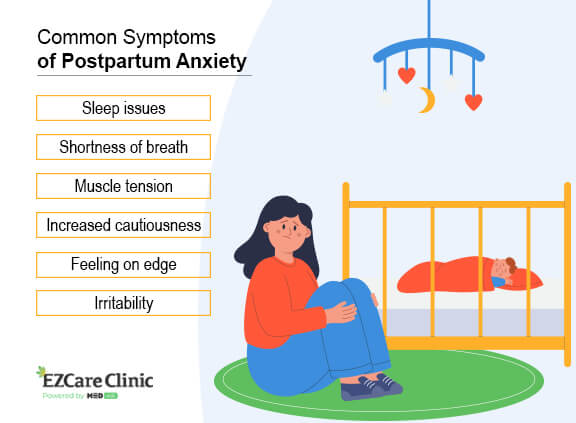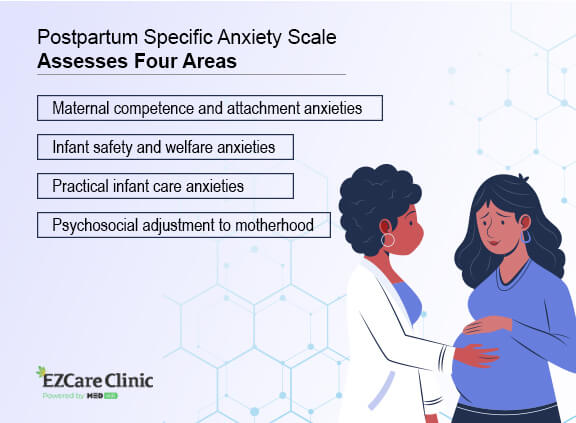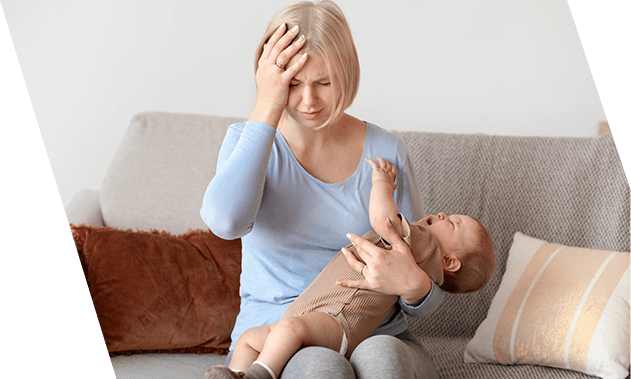Postpartum anxiety is common in many postpartum women and occurs at a higher rate than postpartum depression. Unfortunately, many postpartum women experience anxiety symptoms but lack awareness about this disorder and, as a result, don’t get diagnosed, and their mental health may worsen.
Postpartum anxiety manifests frequently but can be confused with general worries about children. To standardize the diagnostics process and make it simpler, the Postpartum Depression Screening Scale was developed to help measure anxiety and depression. And since some researchers have disputed its validity, a new tool was created — Postpartum specific anxiety scale. Let’s learn more about it.
Experience the symptoms of anxiety? Our licensed doctors are here to offer a personalized treatment plan and guide you to relief.
Postpartum Anxiety
Many postpartum women have endless worries about their young ones. Some typical fears include whether they have eaten well, slept enough, or the laundry piled up a lot? Whereas some fears are normal, a concern arises when the worries go beyond the mother’s control and always keep them on edge.
Postpartum anxiety poses a massive burden to mothers and infants. Common problems they face include:
- Reduced maternal sensitivity.
- Difficult infant temperament.
- Reduced breastfeeding.
- Child’s behavioral and emotional problems.
Researchers have not left a stone unturned in matters concerning postpartum mental health based on the above health impacts. Read on to discover what PSAS is, how it was designed and developed, which instruments it deploys, and how postpartum anxiety relates to the global crisis.
What Is Postpartum Specific Anxiety Scale (PSAS)
The PSAS is a tool that measures anxiety in postpartum women. Dr. Vicky Fallon of the University of Liverpool developed and validated the original PSAS, and two perinatal psychologists supervised the process to ensure quality output.
Generally, the PSAS examines how often women and their infants undergo anxiety during the first year after birth. The scale measures four rationales of anxiety:
1. Maternal competence and attachment anxieties. The domain addresses anxieties about mother-infant relationships, self-efficacy, and motherhood competence.

2. Infant safety and welfare anxiety. Many postpartum women live in constant fear of how safe their infants are. Infant safety and welfare anxiety cover worries about infant accidents, illnesses, and death.
3. Psychological change to motherhood. The rationale addresses managing relationships, work, sleep, and personal appearance.
4. Practical infant care anxieties. As the name suggests, the domain covers matters to do with infant care. For example, general routine, sleep, and breastfeeding.
Maternal mental health practitioners ask a set of questions and assign a score of 1-4 for each question. The answer one represents “not at all” while four represents “almost always.” The maximum score for all the questions is 204. Mothers with a score of 112 or more are considered to have an anxiety level that calls for clinical medication.
PSAS Design and Development: Research Methods
Before the survey, mothers answered a few questions about inclusion criteria. Only those who qualified proceeded to the main survey. Then, the participants filled out an electronic sheet and consent form. After the main survey, the researchers issued a full electronic brief to participants and added them to the prize draw.
Online forms were submitted to parties online via social media and relevant websites. The participants in the survey comprise mothers aged 18-46 based in the UK who had infants from birth to 12 weeks old. Then, the researchers gathered data from the participants when the government declared a social lockdown (23rd March – 10th May 2020).
The questions were based on infant and maternal demographic data. The infant demographic questions were age, birth order, how the infant is fed, and time of birth. Maternal data included country of residence, marital status, occupation, education, etc.
Do you experience the symptoms of anxiety? Consult with our experts to get a diagnosis.
Research Results
The research proved that PSAS has sound psychometric properties; hence it’s accurate and effective for postpartum anxiety assessment. Also, contrary to existing anxiety measures, PSAS has constructs to identify postpartum anxiety in women who do not meet diagnostic criteria for anxiety disorders.
Besides, the PSAS is the first postpartum scale validated for use during a worldwide pandemic. It came in handy with global calls for mental health practitioners to address the cognitive effects of the crisis.
Which Instruments Does Postpartum Specific Anxiety Scale deploy?
PSAS instruments measure various elements of postpartum anxiety to determine the severity. The typical instruments used are EPDS, STAI-S, and PCOS.
- Edinburgh Postnatal Depression Scale (EPDS). The EPDS diagnoses postnatal depression and has a postpartum anxiety scale with a maximum score of 30. The depression level increases with the rise in score. A score above 10 indicates that the mother has postpartum anxiety.
- State-Trait Anxiety Inventory – State scale (STAI-S). The STAI-S tests for situational anxiety on a four-point Likert anxiety scale with scores of 0-80. The higher the mother’s score, the higher her anxiety level.
- Parenting Sense of Competence scale (PSoC). The PSoC has seven items to measure parental competence. Every item has six points, and the higher the points, the higher the mother’s confidence in her parenting skills.
What Is the Relationship Between Postpartum Anxiety and COVID-19?
The pandemic was a global health crisis that saw the vulnerable groups suffer more. Then, pregnant women were considered part of the vulnerable groups, but the guidance changed, and they joined the regular group. Nevertheless, infants were among the vulnerable groups because of their weak immune systems.
The current global crisis has had negative influences on the physical and mental health of postpartum women. Yet, the increase in postpartum anxiety results from the restrictions that the government put in place. Such limits include physical separation and lockdown, which restrict access to avenues for leisure activities.

Conclusion
The research and findings have proven that the PSAS addresses shortages in previous tools and offers a better solution. In addition, the PSAS is a reliable way to measure maternal mental health during postpartum. Finally, PSAS lays a foundation for the development of more postpartum anxiety tests during the global crisis.
There is no need to deal with the symptoms of postpartum anxiety or depression alone. Our certified mental health professionals at EZCare are ready to help by providing a personalized treatment plan. Start with a free assessment and book an appointment to get a diagnosis and proper treatment.



